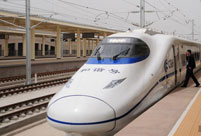 Luoyang aims to become 'Chinese Culture City'
Luoyang aims to become 'Chinese Culture City'
 Century-old jade disc found confirms ancient legend
Century-old jade disc found confirms ancient legend
 A serious mind behind Chinese leader
A serious mind behind Chinese leader
 Panda Cubs to Predict 2014 World Cup Winners
Panda Cubs to Predict 2014 World Cup Winners
 China Southern Airlines flight attendants win titles in service contest
China Southern Airlines flight attendants win titles in service contest
 Pupil's performance art persuades people to stop smoking
Pupil's performance art persuades people to stop smoking
 Nie Chenxi's clay tigers
Nie Chenxi's clay tigers
 Children's Day wishes
Children's Day wishes
 Chinese Kung Fu charms Silicon Valley
Chinese Kung Fu charms Silicon Valley
 Tranquil Yankou ancient town
Tranquil Yankou ancient town
The trial run of the first high-speed railway in China's Xinjiang Uyghur Autonomous Region started on Tuesday. This entire railway, connecting Lanzhou, capital city of Gansu Province with Urumqi, capital city of Xinjiang, is a milestone in Northwest China transportation.
This railway immediately triggered a public debate. Many voices speculate that it is part of a national strategy to consolidate unity of the nation and facilitate counter-terrorism efforts in Xinjiang, while some raise questions whether the railway is economically sustainable.
These questions and doubts make sense, but we must look at a bigger picture. The Lanzhou-Urumqi high-speed rail is a must for Chinese society.
This railway should be regarded as an infrastructure project. Xinjiang, a spacious region which accounts for one sixth of all China, cannot be excluded from the benefits of high-speed rail. This is the fundamental reason, more stable and firm than reasons like counter-terrorism.
This high-speed rail gives Xinjiang an impetus to be a standout region in the pan-Central Asian area. With the prospect of becoming a hub connecting Asia and Europe, Xinjiang's prosperity will boost the development of the whole Silk Road economic belt.
This line will probably face many problems at the initial stage when it goes into operation, such as high ticket price and high vacancy rate. But these costs must be borne if China wants stable and prosperous border areas. In some cases, the rules of the market will not be applicable to the management of borderlands.
For now, no matter how developed transportation vehicles can be, the distance between Xinjiang and the major areas in central and eastern China cannot be shortened effectively. The only option we have is to develop Xinjiang from a remote border region into the center of a pan-Central Asian area.
We are not daydreaming. Xinjiang has the potential to be the key to the rise of inland Asia. The geopolitical changes in Asia have put Xinjiang in an advantageous position.
Still a lot of people are too shortsighted when they observe Xinjiang, and the problems caused by this shortsightedness are consuming Xinjiang's energy. Some macro national strategies such as the Silk Road economic belt have yet to become a platform that can offer consensus to people from central and eastern areas and Xinjiang residents.
This Lanzhou-Urumqi high-speed rail offers a chance for both people in Xinjiang and people in central and eastern areas to have a far-reaching vision, which doesn't have to be hindered by terrorism.
Although this trial run cannot make headlines like terrorist attacks, its influence will be more profound and future-oriented.
 Magnificent Hutiao Gorge
Magnificent Hutiao Gorge  Heat waves hit China
Heat waves hit China Love at the construction site
Love at the construction site Graduation photos bring memories back to life
Graduation photos bring memories back to life Art school students present works in Nanjing
Art school students present works in Nanjing Xinjiang's first high-speed railway goes on trial run
Xinjiang's first high-speed railway goes on trial run 3D Sea-life Themed Art Garage unveiled in Zhengzhou
3D Sea-life Themed Art Garage unveiled in Zhengzhou
 Creative Photos go viral during graduation season
Creative Photos go viral during graduation season Students in last-minute effort for Gaokao
Students in last-minute effort for Gaokao Dali, an ideal summer vacation destination
Dali, an ideal summer vacation destination Xichan Temple's little monk hit the Internet
Xichan Temple's little monk hit the Internet Monologue of a modern dancer
Monologue of a modern dancer College girl proposes to boyfriend on Weibo
College girl proposes to boyfriend on Weibo Special operation members in counter-terrorism training
Special operation members in counter-terrorism training American football brings manhood out of boys
American football brings manhood out of boysDay|Week|Month